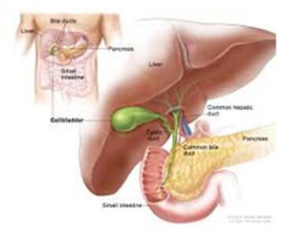Gall Bladder Stones:
Gallstones
 Gallstones are crystals or stone like concretions that can form in your gall bladder. The gall bladder is a small, bluish balloon like structure on the right side of your abdomen, just underneath the liver. The function of the gall bladder is to temporarily store bile and concentrate it. This digestive fluid called bile is produced in the liver and gall bladder stores and concentrates only a part of it. Gall bladder pushes this concentrated bile into the small intestine to help in digestion.
Gallstones are crystals or stone like concretions that can form in your gall bladder. The gall bladder is a small, bluish balloon like structure on the right side of your abdomen, just underneath the liver. The function of the gall bladder is to temporarily store bile and concentrate it. This digestive fluid called bile is produced in the liver and gall bladder stores and concentrates only a part of it. Gall bladder pushes this concentrated bile into the small intestine to help in digestion.
Gallstones can be as small as sand particles or they may become as large as a ‘Jamun’, or even bigger! They can be one or many, and are mostly yellow or black. People who have stones in the gall bladder require gall bladder removal surgery. Since this is performed laparoscopically, it is known as Laparoscopic Cholecystectomy.
Symptoms of Gall Stones
Most of the time, Gallstones may cause no signs or symptoms. If a gallstone lodges in the bile duct and causes a blockage, there can be severe pain along with jaundice. This pain might be associated with nausea and vomiting. If it radiates to back then it indicates occlusion to the flow of pancreatic secretion and the condition is called pancreatitis which is a serious complication of Gall Stones. The pain may last from a few minutes to even days. You must seek immediate care if you develop signs and symptoms of a serious gallstone complication, such as:
- Severe pain in upper abdomen that does not let you lie still.
- Yellowing of the skin or the eyes.
- High fever with chills
Causes of Gall Stones
In majority the cause is not clear.. Various hypothesis has been postulated. It is understood that since bile contains cholesterol, the supersaturation of the bile leads to the formation of Cholesterol Crystals which eventually develop into stones.
Stones are also formed if your gall bladder doesn’t empty completely or regularly the bile may become thick, and stones may form.
Types of gallstones that can form in the gall bladder include:
- Cholesterol gallstones
The most common yellow stones are made up of Cholesterol. - Pigment gallstones
These dark brown or black stones form when your bile contains too much bilirubin.
Factors that may increase the risk of gallstones include
- Female gender
- Age 40 years or older
- Being overweight or obese
- Being sedentary
- Pregnancy
- Eating a high-fat diet
- Eating a high-cholesterol diet
- Eating a low-fiber diet
- A family history of gallstones
- Diabetes
- Having certain blood disorders, such as sickle cell anemia or leukemia
- Losing weight very quickly
- Medications that contain estrogen, such as oral contraceptives or hormone therapy drugs
- Having liver disease
Complications of gallstones:
Inflammation of the gall bladder
A stone can move and block the neck of the gall bladder, that can cause swelling and infection in the gallbladder (Cholecystitis), resulting in severe pain(colic) and sometimes fever.
Blockage of the bile duct
A stone may slip into the tube that carries the bile to the intestines. This can cause severe pain often in the back, jaundice, and fever.
Blockage of the pancreatic duct
The pancreatic duct is a tube that connects to the common bile duct to the pancreas gland just before they enter the duodenum. Pancreatic juices, are strong chemicals which helps in digestion, they flow through the pancreatic duct.
A gallstone when it blocks the pancreatic juices, they spill over in pancreas and cause a severe reaction resulting in unrelenting back pain and vomiting. It is a serious condition which may require ICU care.
Prevention of Gall Stones
Gall bladder cancer
People with long standing gallstones have an increased risk of gall bladder cancer though gall bladder cancer occurs very rarely.
You can reduce your risk of gallstones if you:
- Maintain a routine
Try to stick to your usual mealtimes each day. Prolonged fasting makes you prone to gallstones. - Lose weight slowly
If you are losing weight, make it go slow as rapid weight loss can lead to Gall Stone formation. - Eat more high-fiber foods
Fiber-rich foods such as fruits, vegetables, and whole grains are beneficial in preventing gall stones. - Maintain healthy weight
Obesity and overweight make one prone to this problem, it is a well known observation that gallstones are much more common in obese people.
Diagnosis
- Abdominal ultrasoundis the test most commonly used to look for signs of gallstones.
- Magnetic Resonance Cholangiopancreatography (MRCP) orEndoscopic Retrograde Cholangiopancreatography (ERCP) are indicated to diagnose the stones that may have slipped into the bile duct, such stones can then be removed during the ERCP procedure.
- Blood tests, like CBC, LFTs, Amylase, Lipase can pick up infection, jaundice, pancreatitis, and other complications.
Treatment
The treatment of gall stones is surgical. It is known as Laparoscopic Cholecystectomy
This surgery is performed through three or four small holes and the usual time is 15 min to 30 min. Patients usually stay for 1 day in the hospital. Post-operative pain is minimal and the patient can walk and eat 3 hours after the surgery. There are usually no complications after this surgery.







